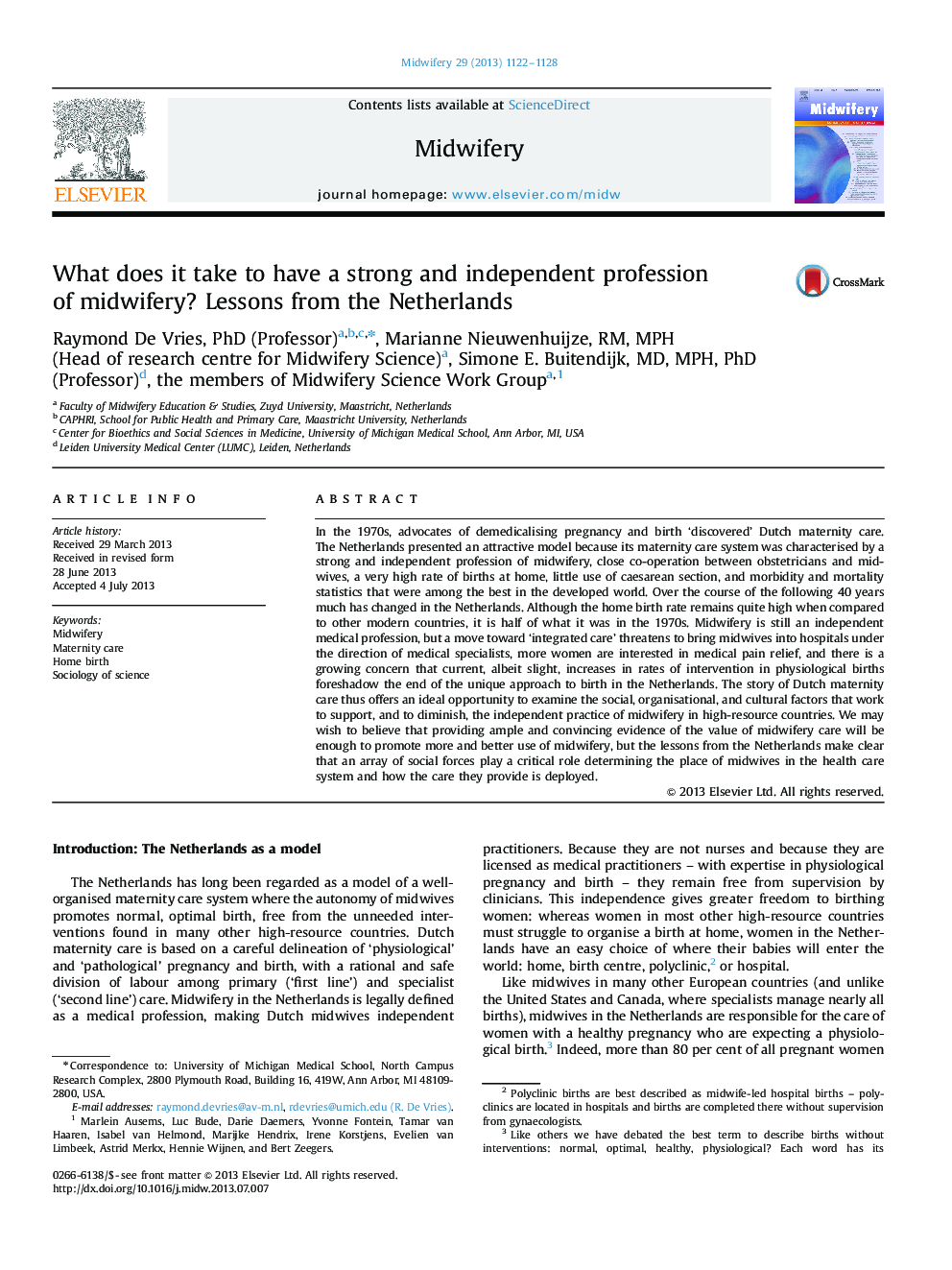| کد مقاله | کد نشریه | سال انتشار | مقاله انگلیسی | نسخه تمام متن |
|---|---|---|---|---|
| 10515860 | 951324 | 2013 | 7 صفحه PDF | دانلود رایگان |
عنوان انگلیسی مقاله ISI
What does it take to have a strong and independent profession of midwifery? Lessons from the Netherlands
ترجمه فارسی عنوان
چه چیزی برای داشتن یک حرفه مستقل و مامایی وجود دارد؟ درسهای هلند
دانلود مقاله + سفارش ترجمه
دانلود مقاله ISI انگلیسی
رایگان برای ایرانیان
کلمات کلیدی
مامایی، مراقبت های زایمان، تولد خانه، جامعه شناسی علم،
ترجمه چکیده
در دهه 1970، طرفداران تخفیف حاملگی و تولد "مراقبت از مادران هلندی" را کشف کرد. هلند الگوی جذابی را ارائه داد، زیرا سیستم مراقبت از مادران از طریق حرفه ای مستقل و ماما، همبستگی نزدیک بین ماماها و ماماها، نرخ بسیار بالای زایمان در خانه، استفاده کم از بخش سزارین و میزان مرگ و میر آمارهایی که در میان بهترین در جهان توسعه یافته بودند. در طول 40 سال بعد، در هلند تغییر کرده است. اگر چه نرخ تولد خانه در مقایسه با سایر کشورهای مدرن بسیار بالا است، اما نیمی از آن چیزی است که در دهه 1970 بود. مامایی هنوز یک حرفه پزشکی مستقل است، اما حرکت به سمت "مراقبت یکپارچه" تهدید می کند که ماماها به سمت بیمارستان ها به سمت متخصصان پزشکی بیاورند، بیشتر زنان علاقه مند به کاهش درد درمانی هستند و نگرانی های روزافزونی وجود دارد، افزایش میزان دخالت در تولد فیزیولوژیکی، پایان دادن به رویکرد منحصر به فرد به تولد در هلند است. بنابراین داستان مراقبت از مادران هلندی، فرصتی ایدهآل برای بررسی عوامل اجتماعی، سازمانی و فرهنگی است که برای حمایت و کاهش فعالیت مستقل مامایی در کشورهای با منابع بالا، ارائه می دهد. ممکن است ما بخواهیم اعتقاد داشته باشیم که ارائه شواهد فراوان و قانع کننده در مورد ارزش مراقبت های مامایی به اندازه کافی برای ترویج استفاده بیشتر و بهتر از مامایی است، اما درس های هلند روشن می سازد که مجموعه ای از نیروهای اجتماعی نقش مهمی در تعیین مکان دارند ماماها در سیستم مراقبت های بهداشتی و نحوه مراقبت از آنها اعمال می شود.
موضوعات مرتبط
علوم پزشکی و سلامت
پزشکی و دندانپزشکی
زنان، زایمان و بهداشت زنان
چکیده انگلیسی
In the 1970s, advocates of demedicalising pregnancy and birth 'discovered' Dutch maternity care. The Netherlands presented an attractive model because its maternity care system was characterised by a strong and independent profession of midwifery, close co-operation between obstetricians and midwives, a very high rate of births at home, little use of caesarean section, and morbidity and mortality statistics that were among the best in the developed world. Over the course of the following 40 years much has changed in the Netherlands. Although the home birth rate remains quite high when compared to other modern countries, it is half of what it was in the 1970s. Midwifery is still an independent medical profession, but a move toward 'integrated care' threatens to bring midwives into hospitals under the direction of medical specialists, more women are interested in medical pain relief, and there is a growing concern that current, albeit slight, increases in rates of intervention in physiological births foreshadow the end of the unique approach to birth in the Netherlands. The story of Dutch maternity care thus offers an ideal opportunity to examine the social, organisational, and cultural factors that work to support, and to diminish, the independent practice of midwifery in high-resource countries. We may wish to believe that providing ample and convincing evidence of the value of midwifery care will be enough to promote more and better use of midwifery, but the lessons from the Netherlands make clear that an array of social forces play a critical role determining the place of midwives in the health care system and how the care they provide is deployed.
ناشر
Database: Elsevier - ScienceDirect (ساینس دایرکت)
Journal: Midwifery - Volume 29, Issue 10, October 2013, Pages 1122-1128
Journal: Midwifery - Volume 29, Issue 10, October 2013, Pages 1122-1128
نویسندگان
Raymond (Professor), Marianne RM, MPH (Head of research centre for Midwifery Science), Simone E. (Professor), the members of Midwifery Science Work Group the members of Midwifery Science Work Group,
